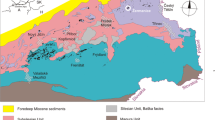Abstract
The steep crest of the Sierra Nevada, California, near Onion Valley, exposes natural cross sections through a mafic intrusive complex that formed as part of the Mesozoic Sierra Nevada batholith. Sheeted sills of hornblende gabbro to hornblende diorite, individually as thick as 1.5 m, form the upper 200 to 300 m of the complex. Thicker, multiply-injected sills, as well as mafic stocks, lie underneath at elevations below 3600 m. Lens-shaped cumulate bodies, as thick as 200 m and more than 700 m broad, lie near the base of the sheeted sill suite. Cumulates are flat-lying, modally layered hornblende gabbro with subsidiary ultramafic olivine hornblendite, plagioclase hornblendite, and late-mobile hornblende-plagioclase pegmatite. Fine grain size, scarce phenocrysts and xenocrysts, and quench mineral textures are evidence that hornblende gabbro sills injected in a largely liquid state and preserve basaltic melt compositions. Most sills reached volatile saturation, as shown by tiny miarolitic cavities that are also widespread in cumulates. Although some sills chilled directly against others, most chilled against septa, millimeters to a few centimeters thick, of medium-grained diorite to granodiorite. Mutually crosscutting relations, as well as chilling, show that the septa were partly molten at the time the sills injected and likely formed the lower portions of an overlying more silicic magma chamber that has since been removed by erosion. Sill compositions range from evolved high-alumina basalt to aluminous andesite with major and trace element abundances similar to those of modern arc magmas. Experimental phase equilibria indicate dissolved water contents near 6 wt% (Sisson and Grove 1993a). The sills show unequivocally that hydrous arc basaltic magmas reached shallow levels in the crust during formation of the largely granodioritic Sierra Nevada batholith. The basaltic magmas appear to have been produced from an enriched mantle source with 87Sr/86Sr ∼0.7065, ɛNd ∼−4.3, 206Pb/204Pb ∼18.6, 207Pb/204Pb ∼15.6, 208Pb/204Pb ∼38.6. Although crystal fractionation contributed to forming the sill suite and the associated cumulates, nearly constant concentrations of Na2O, P2O5, Nb, Zr, and light rare earth elements in the sills indicate that mixing between sill basaltic and more evolved septa magmas was important for producing sills with andesitic compositions. Average Sierran granodiorite major and trace element concentrations are readily reproduced by a simple mixture of average basaltic sill from Onion Valley and average Sierran low-silica granite. This result supports the inference that Sierran granitoids formed chiefly by mixing between crustal and mantle-derived magmas, although in some cases these crustal melts may have been derived by refusion of earlier mafic intrusions near the base of the crust. The common mafic inclusions (enclaves) in Sierran granodiorites bear a superficial resemblance to Onion Valley mafic sills; however, high concentrations of lithophile elements in the inclusions point to extensive chemical exchange between inclusions and their host magmas. The prevalence of hornblende-rich mafic intrusive rocks at Onion Valley, elsewhere in the Sierra Nevada, and in other shallow subduction batholiths stems from two effects of high melt water concentrations (∼4–6 wt% H2O). The hydrous parent basaltic and basaltic andesite magmas had low liquidus temperatures, compared to nearly dry basaltic melts, and thus were chilled less during ascent through the crust and were more capable of ascent as liquids. More importantly, their high water concentrations led to low melt densities, higher than granitoid liquids, but comparable to or less dense than partly solidified granitoid magmas. Thus, the hydrous basaltic and basaltic andesite magmas were neutrally or positively buoyant and were capable of penetrating and rising through partly crystallized granitoids and their partly molten source regions to reach upper crustal emplacement levels. Drier basaltic magmas were probably abundant at depth and contributed heat and mass to granite generation, but were insufficiently buoyant to ascend to shallow levels.
Similar content being viewed by others
Author information
Authors and Affiliations
Additional information
Received: 2 August 1995 / Accepted: 26 June 1996
Rights and permissions
About this article
Cite this article
Sisson, T., Grove, T. & Coleman, D. Hornblende gabbro sill complex at Onion Valley, California, and a mixing origin for the Sierra Nevada batholith. Contrib Mineral Petrol 126, 81–108 (1996). https://doi.org/10.1007/s004100050237
Issue Date:
DOI: https://doi.org/10.1007/s004100050237




